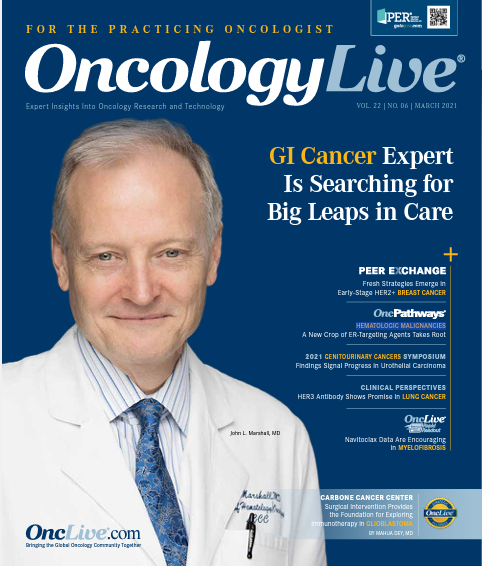Publication
Article
Oncology Live®
Study Tests Guidelines for Monitoring Pancreatic Cysts
Author(s):
Investigators are seeking to determine the optimal protocol for monitoring patients with pancreatic cysts to better identify neoplasms that are more likely to become malignant.
David S. Weinberg, MD, MSc

Investigators are seeking to determine the optimal protocol for monitoring patients with pancreatic cysts to better identify neoplasms that are more likely to become malignant. The ECOG-ACRIN Cancer Research Group is aiming to recruit approximately 4600 people for a long-term study comparing a low- with a high-intensity surveillance approach in the EA2185 trial (NCT04239573).1
Pancreatic cysts are very common findings in otherwise healthy patients as they get older, said David S. Weinberg, MD, MSc, principal investigator on the study. Although cysts have been identified in up to 20% of patients undergoing MRI, the risk of progression to pancreatic cancer varies depending upon clinical and radiographic features.2,3 In surgical studies, the incidence of malignancy ranged from 15% to 25% for certain ductal neoplasms to 0.25% for low-risks cysts.3
“A minority [of cysts] have the potential to turn into cancer,” said Weinberg, who is the chair of the Department of Medicine, chief of the Section of Gastroenterology, and Audrey Weg Schaus and Geoffrey Alan Weg Chair in Medical Science at Fox Chase Cancer Center in Philadelphia, Pennsylvania. “We just don’t know on the day of their identification which ones might and which ones might not.”
Patients with pancreatic cysts are managed with surveillance protocols, but at present there is no consensus on which protocol is the most clinically effective or which is the best use of resources. The 2 major strategies for the management of pancreatic cysts are detailed in the Fukuoka guideline, published initially in 2012 and revised in 2017,4 and the American Gastroenterological Association (AGA) recommendations, published in 2015.5 Significant differences exist between the 2 approaches, with the updated Fukuoka guidelines being the more intensive monitoring program.6
Both guidelines are clinically accepted, and insurance companies cover the costs of monitoring, Weinberg said. “The problem is that nobody knows which one works better or which one adds the most value. Guidelines are supposed to reduce variation in health care because they take the best evidence and make recommendations for providers on how to take care of patients. Competing guidelines sow confusion.”
The Fukuoka surveillance guidelines recommend an MRI or a CT scan at 6 months for cysts less than 1 cm and then every 2 years if there is no change. For cysts that are 1 cm to 2 cm, MRI or CT should be conducted annually, then every 2 years if the cyst is stable. For cysts 2 cm to 3 cm, an endoscopic ultrasound (EUS) is recommended at months 3 to 6; after that, the EUS and MRI can alternate, and the time between scans can be lengthened. For cysts greater than 3 cm, the guideline recommends alternating between MRI and EUS every 3 to 6 months.4
In the Fukuoka guidelines, surgery is recommended if the EUS reveals main duct features that are suspicious or cytology that is suspicious or positive for malignancy. The guidelines also recommend that resection be considered for cysts greater than 3 cm in younger patients who would otherwise require prolonged surveillance.6
The AGA guideline recommends MRI in the first year, then every 2 years, for cysts less than 3 cm, with surveillance if there is no significant change in size or characteristics.
For cysts with higher-risk features, including size greater than 3 cm, the guideline recommends examination with an EUS with fine-needle aspiration (FNA). If these results are not suspicious, patients can undergo MRI after 1 year and then switch to every 2 years.
Patients with significant changes in the cyst are advised to undergo an EUS with FNA, and then are referred to the surgery department.5
“As you would predict, the more intensive surveillance strategy finds more cancers. It also provokes more surgery that is unnecessary or not useful,” Weinberg said. “Having surgery to remove what turns out to be a benign cyst, unfortunately, exposes patients to substantial risk.
“With all the best intentions, we are operating on a lot of people that if we knew they didn’t have cancer we wouldn’t want to operate on, and we are periodically letting patients slip through our fingers whom we might have been able to protect,” he added.
He said the Whipple procedure, or pancreaticoduodenectomy, is the most frequently performed pancreatic resection, but this is a complex surgery and is associated with serious complications. In a retrospective analysis involving 4945 patients, the rate of serious complications was 27.1%, most frequently sepsis (15.3%), surgical site infection (13.1%), and respiratory complications (9.5%). The mortality rate within 30 days was 2.6%.7
FIGURE. Comparing 2 Methods to Follow Patients With Pancreatic Cysts

SURVEILLANCE STUDY DETAILS
The ECOG-ACRIN study will randomize patients to 1:1 to surveillance with either a low-intensity protocol modeled on the AGA guidelines or a high-intensity strategy based on the Fukuoka guidelines (FIGURE1,8). “The most salient differences between the 2 surveillance strategies center on indications for and recommended intervals of cross-sectional imaging and EUS utilization,” Weinberg and colleagues said in an article in Contemporary Clinical Trials.8
In the low-intensity arm, patients will undergo MRI or a CT scan at the beginning of the trial and again in 1 year. Participants with no abnormalities will repeat the MRI or CT every 2 years. Those with positive imaging features at 1 or 2 years will undergo an EUS. If the EUS is negative, participants will repeat the MRI or CT in 1 year.8
In the high-intensity arm, patients also will undergo MRI or CT at study entry. Those with 1-cm to 2-cm cysts will receive an MRI or CT every 6 months for 1 year, then every 12 months for 2 years, and then every 24 months thereafter. Patients with 2-cm to 3-cm cysts at baseline will undergo an EUS within 6 months; if that test is negative, they will repeat the MRI or CT in 1 year. If a second EUS is negative, patients will undergo alternate MRI or CT and EUS every 12 months. Patients with cysts larger than 3 cm will undergo EUS within 6 months, and if that is negative, they will alternate MRI or CT with EUS every 3 to 6 months.8
Participants in either arm will be recommended for surgery if they develop obstructive jaundice due to the pancreatic cyst; an enhancing nodule 5 mm or larger in the cyst wall; or main pancreatic duct dilation of 10 mm or larger.
The primary end point of the study is a comparison of unfavorable outcomes within each arm. Unfavorable outcomes are defined as any pancreatic cancer without surgery; unresectable pancreatic cancer or cancer larger than T1a, N0 at surgery; or benign disease at surgery. Favorable outcomes would be high-grade dysplasia and/or resectable, early-stage pancreatic cancer (T1a, N0) at surgery, or benign disease and no surgery.8
“For statistical reasons, the power of the study is driven by a comparison of the unfavorable outcomes across arms,” Weinberg said.
Secondary end points include clinical measures such as surgical mortality and major morbidity rates, health care resource utilization costs and metrics, and patient-reported outcomes.
The study, which is scheduled to last for 8 years, aims to enroll patients in 150 sites across the United States. Eligible patients are those with newly identified pancreatic cysts greater than 1 cm. Weinberg said investigators are exploring opening the enrollment to international sites.
The coronavirus 2019 (COVID-19) pandemic has affected enrollment efforts, Weinberg said. Health care use is low for any nonemergency service.
“This is clearly meant to be a prevention trial,” he said. “Patients are not getting the CT in the first place that shows the cyst. And even if they do get that CT that finds a pancreatic cyst, patients are asking their doctors if surveillance can wait until after they are vaccinated. At Fox Chase pre-COVID, we probably saw 3 to 5 new patients per week who would have fit the inclusion criteria for this trial. At this point, we’re probably seeing 1 patient every week or so.”
Investigators will also collect biosamples from patients over time that will be banked for possible evaluation for biomarkers. The hope, Weinberg said, is that in addition to reliably identifying the most clinically effective surveillance strategy, investigators can identify better ways to determine which cysts could become cancer.
“People are coming up with new biomarkers all the time. Hopefully, by the time this trial is over, there will be better ones, and we’ll have this treasure trove of patients (a lot of them), biosamples on most of them, and clinical outcomes on all of them to see if there are any markers that predict cancer,” he said.
References
- Comparing two methods to follow patients with pancreatic cysts. ClinicalTrials.gov. Updated May 21, 2020. Accessed February 22, 2021. https://clinicaltrials.gov/ct2/show/NCT04239573
- Stark A, Donahue TR, Reber HA, Hines, OJ. Pancreatic cyst disease: a review. JAMA. 2016;315(17):1882-1893. doi:10.1001/jama.2016.4690
- Snyder RA, Roland CL, Boughey JC, Rocha FG, New trial aims to settle debate on the intensity of pancreatic cyst surveillance. Bulletin of the American College of Surgeons. October 1, 2020. Accessed March 3, 2021. https://bit.ly/2Pl8hSr
- Tanaka M, Fernández-del Castillo C, Kamisawa T, et al. Revisions of international consensus Fukuoka guidelines for the management of IPMN of the pancreas. Pancreatology. 2017;17(5):738-753. doi:10.1016/j.pan.2017.07.007
- Vege SS, Ziring B, Jain R, Moayyedi P; Clinical Guidelines Committee; American Gastroenterology Association. American Gastroenterological Association Institute guideline on the diagnosis and management of asymptomatic neoplastic pancreatic cysts. Gastroenterology. 2015;148(4):P819-822. doi:10.1053/j.gastro.2015.01.015
- Hasan A, VIsrodia K, Farrell JJ, Gonda TA. Overview and comparisons of guidelines for management of pancreatic cystic neoplasms. World J Gastroenterol. 2019;25(31):4405-4413. doi:10.3748/wjg.v25.i31.4405
- Greenblatt DY, Kelly KJ, Rajamanickam MDS, et al. Preoperative factors predict perioperative morbidity and mortality after pancreaticoduodenectomy. Ann Surg Oncol. 2011;18(8):2126-2135. doi:10.1245/s10434-011-1594-6
- Weinberrg DS, Gatsonis C, Zeh HJ, Carlos RC, O’Dwyer PJ; on behalf of the E2185 Team. Comparing the clinical impact of pancreatic cyst surveillance programs: a trial of the ECOG-ACRIN cancer research group (EA2185). Contemp Clin Trials. 2020;97:106144. doi:10.1016/j.cct.2020.106144








%20u.jpg?fit=crop&auto=format)

